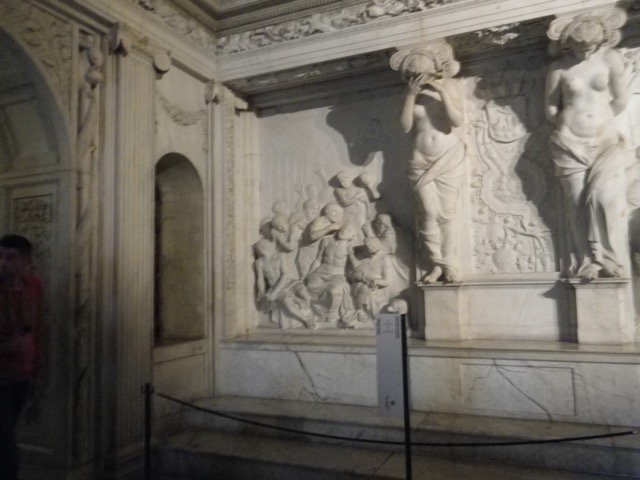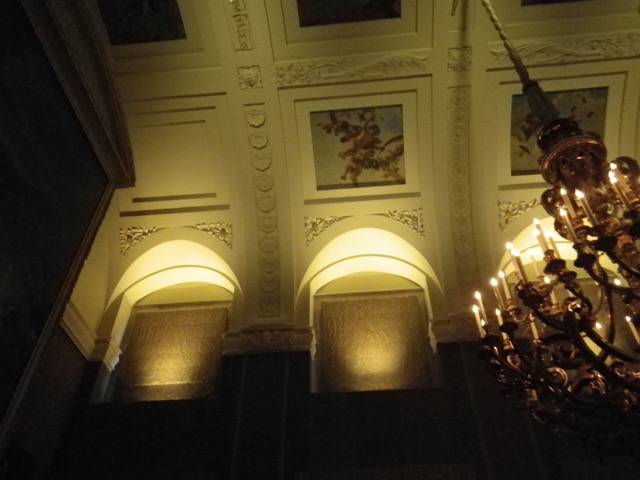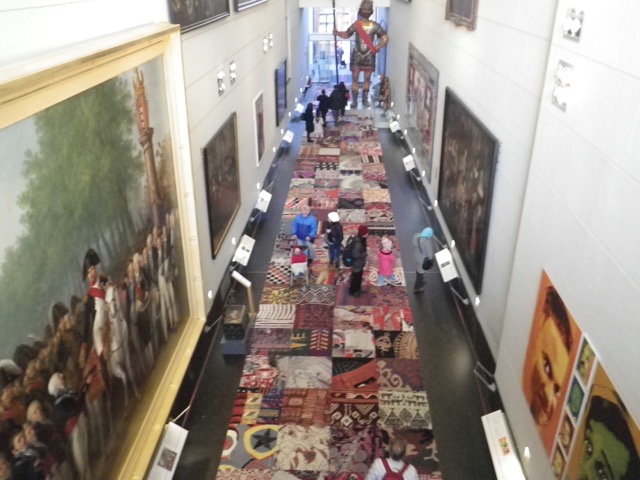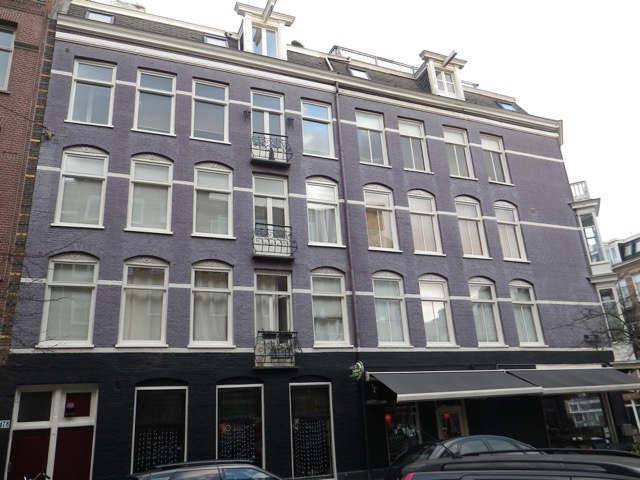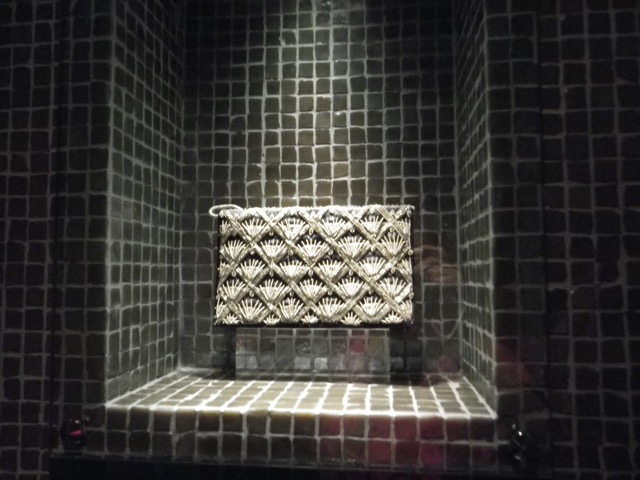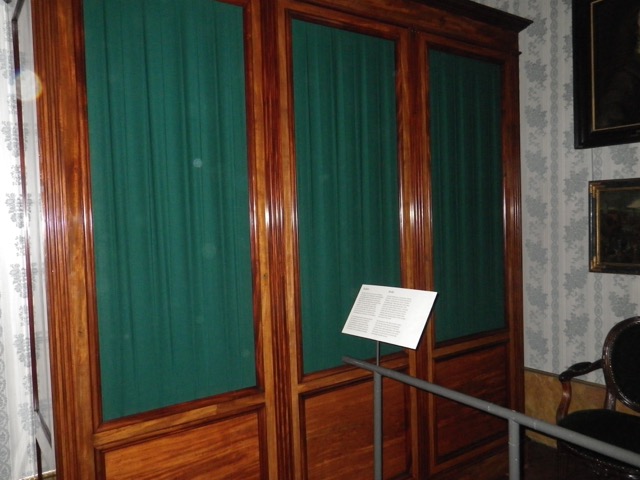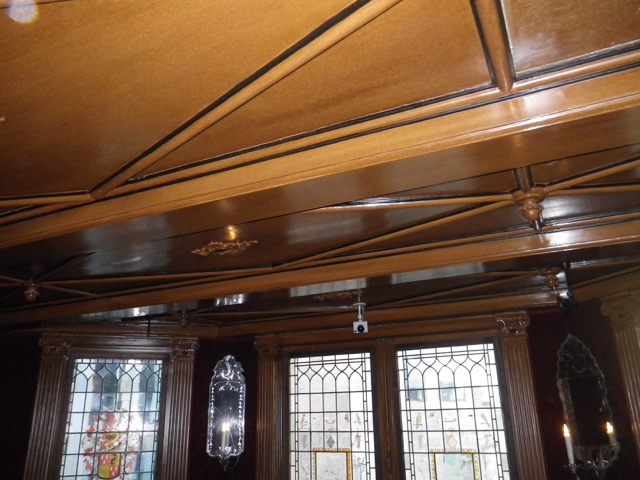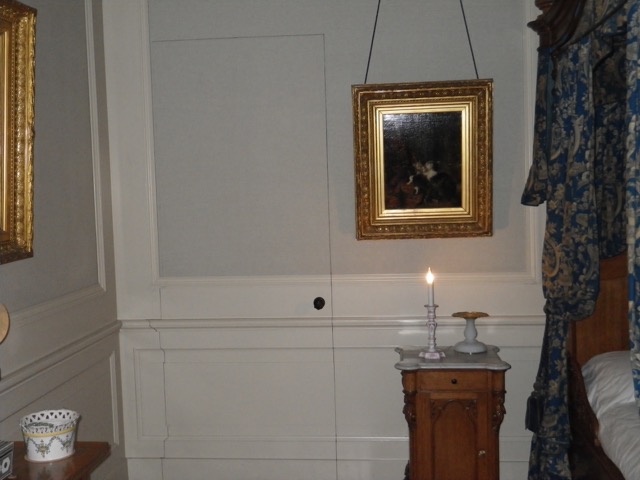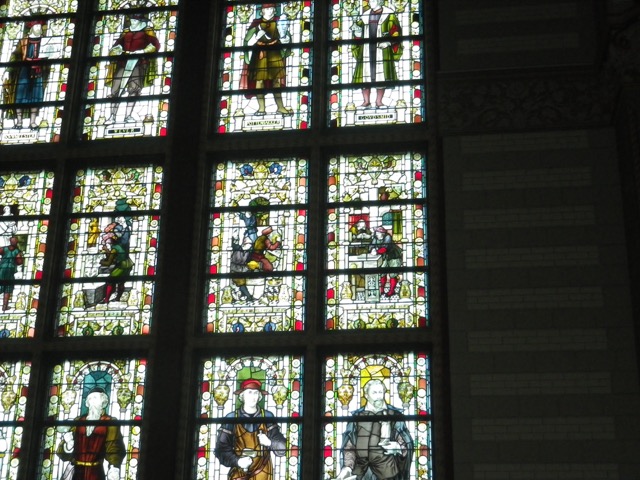One of my orders for today never showed up (not a huge surprise with that client) and another one was mostly blank air — that I still get paid for in full. So I was done for the day by noon! Woohoo! I decided to head to Chinatown for lunch and then visit the Royal Palace of Amsterdam. Other than doing a proper tour of the Rijksmuseum, that would cover me for all the major Amsterdam Museums in case work really did end up pouring in. Spoiler: I really won’t have time to go out the next two days. And with the weather being as close to freezing and as foggy as it was today, I don’t think I would have made it out had I not had my Museumkaart as motivation, so yay for it!
Downtown Amsterdam has these neat electronic billboards with a switch that you can press to bring up a city map. I did that when the map suddenly switched to this amazing advert for “Sherlock,” whose next season I am ridiculously excited about being able to watch in real time (one episode here in Amsterdam, one in Hebden Bridge, and one at the cinema in Halifax!). This was very effective advertising and I actually caught several as I headed towards Dam Square.
For some stupid reason, I cannot stop using Google Maps even though it is a waste of space on my phone, so I ended up wandering around the Red Light District/Chinatown in circles trying to find the restaurant I was headed to. So yay for some extra sightseeing, if I want to be positive. But the app finally got deleted! Good riddance to rubbish taking up precious space on my phone.
You know how folks seem to think that French looks and sounds all pretty? Let me just say that the translation of that text is not lovely!
I found the New Season Chinese restaurant that had good reviews and was listed as a favourite by locals as well as considered “cheap eats” by Amsterdam standards. I really wanted some meat (trying to eat vegetarian at home to respect my vegan hosts), so I ordered a chicken and veggie stir fry with udon noodles and added very spicy red chile paste. SO good!
The server spoke perfect English and was very friendly, making me feel very welcome. She was quick with my drink order (beer, of course, since it’s practically the same price as anything else) and checked up on me. 13 euros total, which, believe me, is a good price for a sit down lunch with a beer in the parts of Amsterdam that I’ve been!
I then doubled back to Dam Square, which was VERY busy.
I have no idea how people find their bicycles!
Lots of people and pigeons in front of the Royal Palace. Darth Vader was playing a lament, presumably to Princess Leia. RIP.
One of the most amazing things that has come out of this great European adventure was seeing this sign and being able to giggle at the fact that I could recognise that they dropped the ball with the Russian! For those who are curious, the first word of the second line should be the second word of the first line, ie. in the big letters. “Welcome” is two words in Russian, so they basically have the Russian as “WEL (new line) come to…”
There was a very long queue to get into the Royal Palace. As I got closer to the ticket booth, a security card called out to anyone with a ticket or membership card of some type to go to him. I figured I qualified, so I did that and was able to not only get ahead of about two dozen people, but snag one of the last free audio guide players! The benefits of the Museumkaart aren’t just monetary!
The reception area was very busy, so I was surprised that there was barely any wait at the coat check.

I’m surprised by how much I love these monochromatic and rather posh Christmas decorations, considering how I tend to prefer bright colours and rougher textures.
The following is verbatim from several informational placards in the lobby area.
“The Royal Palace was built in the 17th century as the Town Hall of Amsterdam, after a design by Jacob van Campen. Its paintings and sculptures were made by some of the most distinguished artists of the time and allude to the city’s influence and prosperity in the Dutch Golden Age.
“In 1808, Louis Napoleon, brother of the French Emperor Napoleon Bonaparte, became King of Holland and converted the Town Hall into a Palace. The superb collection of Empire furniture, clocks, and chandeliers date from that period. The collection of Empire furniture is one of the best preserved and most complete collections in the world.”
“The Royal Palace of Amsterdam is one of three Places used by the Dutch Monarchy, notably for State Visits, Award Ceremonies, New Year’s Receptions, and other official functions. The building plays a role in royal marriages and in the abdication and investiture of the Monarch. When the Palace is not in use by the Royal House, it is open to the public.”
The tour was too fast paced and crowded to take notes, so I unfortunately have to rely on memory for everything the audio guide told us as there is very little actual signage within the palace. You also cannot use a flash, so most of my pictures are terrible. I’m going to include a few to show just how magnificent the building is, but, really, I cannot do justice to it. Do know that the building was embellished and turned into royal apartments during a two-year period at the start of the 19th century.
I started my tour in the last room because it wasn’t too crowded. This is the Tribune, where sentences were carried out in view of spectators in Dam Square.
There are three scenes portrayed in marble. This one is from the story of judge who would take both eyes of a rapist found guilty. One day, his son came before him and so the judge’s sentence was that his son lose only one eye and he, the judge, would lose an eye of his own.
This story was memorable. Two women are fighting over a child and there is a dead child at their feet. The judge has to decide who is the real mother of the child. So he rules that the living child will be cut in half. At this ruling, one of the women relinquishes her claim on the child, identifying her as the real mother.
Looking up to the Proclamation Chamber:
The doors into the tribunal were also works of art:
This is the lectern where the sentence would be read.
People in Dam Square would look through these grates to see justice carried out.
Lady Justice is blind.
I then headed upstairs to the main part of the palace and all the public rooms available to view.
You enter into the magnificent Citizen’s Hall, which was meant to represent the World. It was originally a public space, then became a reception hall for the monarch. There are maps on the floor and the room is anchored by Atlas. Like in all the rooms, the audio guide explained the original purpose of the room when the building was the town hall, then the royal purpose, and finally, the modern purpose. You could also listen to optional audio about various objections. So, really, that was a lot of information to remember!
I could see Nova Scotia and Acadia (New Brunswick) on this map.
From this room, halls lead to the north and south galleries. The space is confusing to get around, but the audio guide does a good job of getting folks from one room to the next in a logical fashion. I got misplaced at one point, but a very helpful security guard got me sorted.
At this point, I was being bombarded with information, so I’m just going to give the name of each room and a picture or two. They all started to look alike and, frankly, I can’t remember which room with the word magistrate was once a queen’s apartments or the difference between the different treasuries!
Magistrate’s Chamber:
Little hallway space leading to the next room (I liked the floor).
Bust of the monarch Louis Napoleon (I think that was his name…).
Commissioners of Petty Affairs, where small things like neighbourly disputes were settled. I do remember that if you swore in this room, you had to pay one guilder!
Treasury Extraordinary:
This is the first room I encountered that has a bed. Get this. It’s actually a bedroom when the palace is closed to the public and has visitors. Can you imagine trying to relax in this room???!!! It was at this moment that it truly sunk in that I was not in a museum, but in a working building.
We exited into the South Gallery.
The Secretary’s Office:
Here’s the Treasury Ordinary, which is another bedroom:
Then the Burgomasters’ Cabinet:
And the Burgomasters’ Chamber:
I found myself in the Balcony Room/Proclamation Gallery looking down to the Tribune. This room leads to a balcony overlooking Dam Square where the Royal Family will present children, kiss at weddings, and do other such things, just like we see at Buckingham Palace in the UK.
Next up was the very cheerily named Execution Chamber, where the condemned would be brought up from the tribune to pray before being executed. After the building became a palace, it was a reception room for the Queen.
Next up, the City Council Chamber. This is where the modern monarch abdicates and the successor has his or her inauguration. Abdications and inaugurations? I’m not up on the protocols of the Netherlands royal family either, but it is quite different from that of the UK.
Then, I got lost on the way to the next room and found the Insurance Chamber, where I learned that insurance rates in Amsterdam were so low that people came from all over to buy their insurance.
Then, the Bankruptcy Chamber, where Rembrandt’s bankruptcy was processed (these two rooms appear to be mirror images of each other):
I made my way back to the Citizen’s Hall and a staff member directed me to my next destination, the Orphan’s Chamber, where the lives of children with only one or no parents were administered. Orphanages were also run from this room, which is now a bedroom for state functions. I’m trying to imagine myself as a guest sitting at that table writing a blog post…
Then, the Chamber of Accounts, whose bed actually looks comfy:
I can almost imagine curling up on that sofa. Almost.
The Chamber of the Magistrates Extraordinary:
That concluded my tour. I headed back out to Dam Square through these heavy doors. The wind was bitter and needling rain that threatened to turn to snow stung me.
One last glimpse before braving the weather.
The famous balcony:
The Royal Palace of Amsterdam is a breathtaking space, especially its Citizen’s Hall, and I learned a lot about the administration of Amsterdam during three periods of history. It’s definitely a must-see!
I stopped at the large Albert Heijn behind the Royal Palace to get some groceries and was rather overwhelmed by all the offerings and how Dutch can look so much like French and English in many regards, but not where it matters, like on ingredient lists! I was hoping to get sushi for dinner, but this store only had large plates of it.
Tired of throngs, I decided to try to make my home home through quieter streets and maybe even find the Albert Heijn where I got sushi over the weekend. Well, I made my way there with no detours! They had the smaller plates of sushi (yay!) and I was able to get home without any problems, although I didn’t take the exact same route I took on Sunday. It’s amazing to be getting somewhat orientated in such a confusing layout of a city. Once again, I am so very grateful to have the chance to truly live in Amsterdam in a proper home in a non-tourist area.










